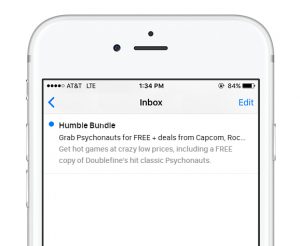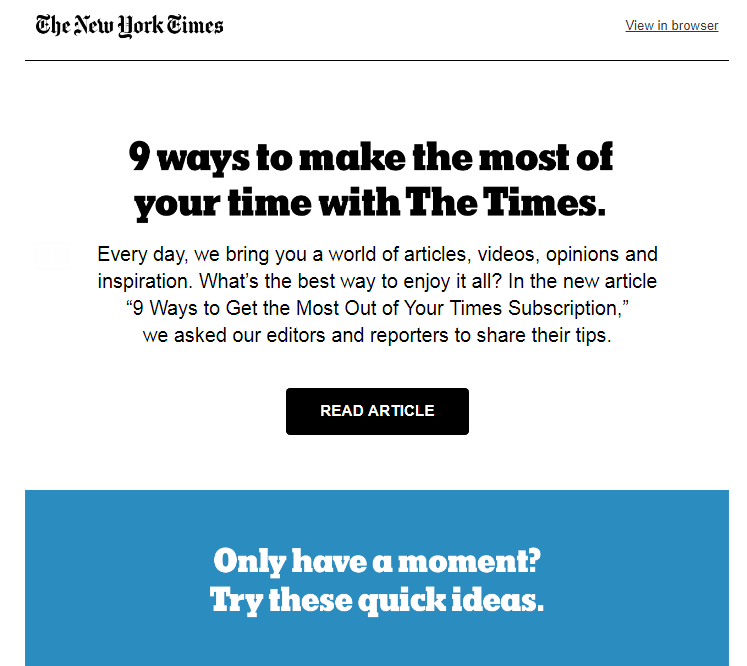
16 Oct 6 Tips to Building Effective Email Marketing Campaigns
Email marketing has returned in full force, and companies that know their way around best email practices will reap the largest returns.
According to a survey of marketers conducted last summer, the average ROI (Return on Investment) from email campaigns was over 100 percent! This ROI beat out other marketing channels by over four times, including social media, paid search, and direct mail.
One study from 2015 even found that email marketing could generate as much as $38 for every $1 spent, which equals a mind-blowing 3,800% ROI.
If you want more out of your email marketing or want to turn around your lackluster campaign success, here are 6 pointers for increasing the effectiveness of your email marketing efforts.
1. Segment Your List (Or Risk Being Irrelevant)
Talk to people about topics, products and ideas they are interested in. Don’t blast your entire list with the same email content.
According to an infographic by Mailigen, using segmented, relevant messaging more than doubles your open rate while driving 18x more revenue for your campaigns.
This concept is easy to understand if you’ve ever been to a party or a business conference mixer. Do you speak to every person the same way and about the same topics? Of course not. The ebb and flow of dialogue makes each conversation unique to that individual based on what they reveal about their interests, experiences, etc.
Think of it this way: Sending a one-size fits all email to your entire list is like speed-dating — you don’t take the time to speak to the person on his or her level so you never make a connection. And without a connection, your email will never resonate and the reader will never take action.
Not having email segments is the same thing. You send the same message to every person without considering whether or not it is relevant to the individual. Ensure your list is segmented by buyer persona so that every message is as relevant as possible.
For people who self-subscribe, you can even give them a chance to customize the content they receive by interest, product category and other choices from a pick-list. Just don’t count on them to do all the work of segmenting for you!
Using an email automation system like Constant Contact or Mailchimp is critical to keeping these segments organized, but you can also potentially do-it-yourself by just separating your mailing lists into separate content buckets. However, if this is too daunting a task, consider running an Email Segmentation Campaign that will offer readers a clear opportunity to self-segment based on the content they choose to read.
Once you have segments established, take a moment to strategize the difference between each segment based on consumer traits; next, buyer progress through your sales pipeline and other situations. Then, outline the type of content that would be most relevant to each segment as well as least relevant and therefore not sent.
Taking a moment to get to know your audience can dramatically increase your open rates while lowering the amount of frustrated subscribers.
2. Use Personalization to Make Recipients Perk Up
When we hear our names — even if we know it’s someone else with the same name being called — we tend to take notice. Chances are good that your parents were pros at this technique. When they said your name before a sentence, you knew they meant business!
We have the same reaction when we see our names in an email. Personalization with a name and other details increases open rates by 26 percent, and it can even help drive brand affinity.
Note that personalization involves more than just adding a first name to an email. The entire message should be framed as if the recipient is having a 1:1 conversation with the sender. LinkedIn has become a pro at this tactic. They use personalization in a way that makes you sit up and listen.

The above message not only includes a name but signals that an exciting activity has happened. It says people are looking at your profile. Think of ways to mirror this effect so people get excited or intrigued just from looking at a subject line.
Segmenting your user base by the products they have bought (or expressed interest in) is another way to connect more deeply right from the subject line. “New Jeep Anniversary Fog Lights” can be a way for a Jeep Wrangler owner to have immediate interest, for instance.
Data shows that this type of personalization is table stakes for marketers with successful email programs. “88 percent of those that exceeded revenue expectations have personalization measurement systems in place,” says Inc.
3. Test Subject Lines Rigorously
A lot of marketers mess up promotional emails right from the moment they begin creating the subject line. And you will, too, unless you scrutinize your subject line, get in-house feedback from a fresh set of eyes, and A/B test different subject lines before rolling out massive campaigns. You have to be patient at this stage because you’re eager to just launch the email campaign. But with an ineffective subject line, you’re doomed to failure and can burn your list.
So the first step is to make sure you are using some sort of subject line preview tool, like this one. Seeing your subject line visually helps you better-imagine how a recipient would react to it in their Inbox.
Take special note of how the email looks on mobile devices since over half of email opens come via mobile. People tend to filter out what emails to read by the subject line alone. 69 percent of email recipients will report a message as spam based solely on the subject line.
Worst words to use include:
- FREE
- $$$
- Earn
- Guaranteed
- Whitepaper, journal, report
Some of the best words include:
- [Recipient Name]
- You/Your
- Thank you
- Account
- Monthly
- Subject 1 | Subject 2 | Subject 3 (e.g. “Bid Bonds | Liability Insurance | Worker’s Comp”)
Note that not every “common marketing knowledge” pointer like this list may work for you and your audience. Always test to be sure!
4. Promise to Not Waste Their Time by Always Offering Value
Thinking like a recipient means coming up with ways to offer something they might actually want. Again, you need to know your buyer personas to do this well. For sales and promotional offers, think of the hottest product they might want or the best offer possible. Don’t just tell them there’s a “sale”; tell them what that means.

When offering something non-material, like information, explain clearly how the contents of the email benefit the user. It could be something deep/important like “Want More 5 Star Reviews☆☆☆☆☆?” or even the promise that “You’ll Laugh Way Too Hard at These Marketing Puns”.
Many email marketers find great results by telling their audience how they can get more out of the products or services they already use.
The New York Times has perfected this strategy. Since there are a million different pieces of content on their site other than what you see on the homepage, they take it upon themselves to inform subscribers about how they can learn and do more on NYTimes.com.

5. Use Powerful Images and Video to Get a Reaction
HTML-based email templates have transformed inboxes from a boring wall of text to a gorgeous place for showcasing compact content or well-designed advertisements.
Images are especially important for mobile since they make messages more colorful and intriguing as well as easier to read on a smaller screen. Since 80 percent of email users are expected to access their inbox via mobile at least some of the time by 2018, thinking about their needs is vital.

Using human-centered images like this stock photo can invoke emotion and draw the eye to certain email sections.
However, make sure you have text-only alternatives for image blockers, and try not to go too overboard with the images you use. Using images in a sloppy or unappealing way can sometimes hurt rather than help.
Using video embedded within email or as a link can likewise help you improve open rates and click-throughs. According to one source, just using the word “video” in a subject line can boost click-throughs by 65 percent and opens by 19 percent.
6. Tell People What to Do with a Single Call to Action
This one is simple: every email should have a call to action (CTA).
Your CTA can be nearly anything, including:
- Go buy this product
- Take advantage of a limited-time offer
- Try our tips
- Go learn/read more at this page
- Attend our event
- Upgrade your current service package
- Book a free consultation
Ensure that your CTA is crystal clear and compelling. Every recipient should know exactly what you want them to do and how to do it. Make sure the CTA is specific to what they are receiving by staying away from the generic, such as Submit or Click Here.
Providing a landing page after clicks to direct them more linearly to an offer can help simplify the process further. It focuses their attention entirely on that CTA so they don’t get distracted and jump away before the action is taken. This also allows you to Retarget your readers to receive digital ads going forward, thus improving your conversion rates further.
Make sure your CTA is singular. If you try to squeeze multiple CTAs into your email or onto your landing page, you will confuse your reader and reduce your conversion rates. Your content is meant to funnel the audience down ONE possible path. This practice will help your click-throughs thrive.
Bonus Tip! Did we say only 6 tips?
7. Study Email Marketing Analytics Like You Have a Test Coming Up
Lots of email marketing strategies tend to work well across the board for a majority of industries, but there is no single set of hard-and-fast rules. Instead, every company has to study their own data in order to find what their audience seems to like/dislike about their emails.
Learn more from your email analytics and use the lessons to optimize your approach over time. Trial-and-error is the only way to truly get better at something, and luckily email gives you plenty of lessons in the form of data.
However, having your email automation connected to a state-of-the-art customer relationship management tool (CRM) will vastly improve the relevance of your data. It is one thing to know your open rate and click-through rate, but it is another to track those actions right through to a conversion. This might be a form submission or a purchase. Integrating your email automation with a robust CRM, such as Sharpspring or Hubspot, also helps you build better segmented lists moving forward.
Stick to Best Practices to Drive Success in Email Marketing
Mastering email marketing takes a lot of experimentation, practice, trial-and-error and attention to detail, but by following the best practices mentioned above, you will be well on your way to greater success. Just have patience.
To recap our 6 tips toward your success:
- Use segmentation to maximize relevance
- Personalize emails to get attention
- Test subject lines, mind your length and think like a recipient
- Promise true value to the recipient through your word choice and messaging
- Use emotional images in your layout
- Direct people to act with a single strong CTA
- BONUS TIP: Use analytics data to optimize your approach over time
Pay attention to what your data tells you, and keep up with the latest email marketing trends and advice on our blog to learn best practices that make you an email genius over time!


